
Carl Eduard Hellmayr was an Austrian ornithologist.

Henry Boardman Conover was an American soldier, salesman, and amateur ornithologist.

The typical honeycreepers form a genus Cyanerpes of small birds in the tanager family Thraupidae. They are found in the tropical New World from Mexico south to Brazil. They occur in the forest canopy, and, as the name implies, they are specialist nectar feeders with long curved bills.
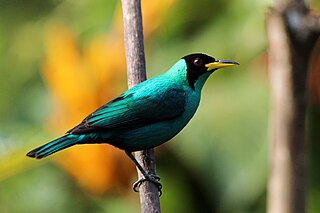
The green honeycreeper is a small bird in the tanager family. It is found in the tropical New World from southern Mexico south to Brazil, and on Trinidad. It is the only member of the genus Chlorophanes.

The purple honeycreeper is a small Neotropical bird in the tanager family Thraupidae. It is found in the tropical New World from Colombia and Venezuela south to Brazil, and on Trinidad. A few, possibly introduced birds have been recorded on Tobago.
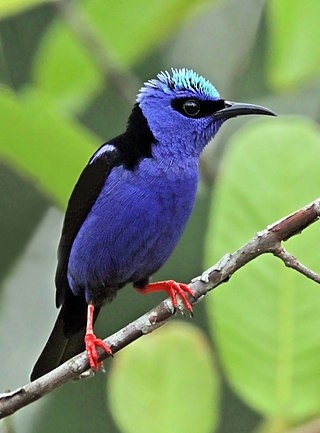
The red-legged honeycreeper is a small songbird species in the tanager family (Thraupidae). It is found in the tropical New World from southern Mexico south to Peru, Bolivia and central Brazil, Trinidad and Tobago, and on Cuba, where possibly introduced. It is also rarely found in southern Texas.

The blue dacnis or turquoise honeycreeper is a small passerine bird. This member of the tanager family is found from Nicaragua to Panama, on Trinidad, and in South America south to Bolivia and northern Argentina. It is widespread and often common, especially in parts of its South American range.

The crested guan is a Near Threatened species in an ancient group of birds of the family Cracidae, which are related to the Australasian megapodes or mound builders (Megapodiidae). It is found from central Mexico through Central America and in Colombia, Ecuador, Peru, and Venezuela.
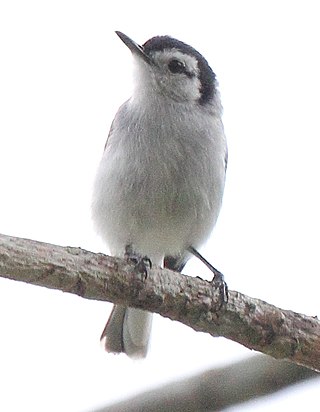
The tropical gnatcatcher is a small active insectivorous songbird, which is a resident species throughout a large part of northern South America. It was formerly considered as conspecific with the white-browed gnatcatcher.

The elm cultivar Ulmus 'Purpurea', the purple-leaved elm, was listed and described as Ulmus Stricta Purpurea, the 'Upright Purpled-leaved Elm', by John Frederick Wood, F.H.S., in The Midland Florist and Suburban Horticulturist (1851), as Ulmus purpureaHort. by Wesmael (1863), and as Ulmus campestris var. purpurea, syn. Ulmus purpureaHort. by Petzold and Kirchner in Arboretum Muscaviense (1864). Koch's description followed (1872), the various descriptions appearing to tally. Henry (1913) noted that the Ulmus campestris var. purpureaPetz. & Kirchn. grown at Kew as U. montana var. purpurea was "probably of hybrid origin", Ulmus montana being used at the time both for wych elm cultivars and for some of the U. × hollandica group. His description of Kew's U. montana var. purpurea matches that of the commonly-planted 'Purpurea' of the 20th century. His discussion of it (1913) under U. campestris, however, his name for English Elm, may be the reason why 'Purpurea' is sometimes erroneously called U. procera 'Purpurea' (as in USA and Sweden.

The Lānaʻi hookbill is an extinct species of Hawaiian honeycreeper. It was endemic to the island of Lānaʻi in Hawaiʻi, and was last seen in the southwestern part of the island. George C. Munro collected the only known specimen of this species in 1913, which is housed in the Bernice P. Bishop Museum in Honolulu, and saw the species only twice more, once in 1916 and for a final time in 1918. No other sightings have been reported. They inhabited montane dry forests dominated by ʻakoko and ōpuhe. The Lānaʻi hookbill was monotypic within the genus Dysmorodrepanis and had no known subspecies. Its closest relative is believed to be the ʻōʻū, and some early authors suggested that the Lānaʻi hookbill was merely a deformed ʻōʻū. The Lānaʻi hookbill was a plump, medium-sized bird with greenish olive upperparts and pale whitish yellow underparts. It also had a yellow or white superciliary line and a white chin and throat. The wings also had a distinctive and conspicuous white wing patch. The hookbill's distinguishing characteristic was its heavy, parrotlike bill, which had the mandibles hooking sharply towards each other, leaving a gap between them when the beak was closed.

The scarlet-thighed dacnis is a tanager 4¾" long. It is found in Costa Rica, Colombia, Ecuador and Panama.

The golden-collared honeycreeper is an uncommon species of Neotropical bird in the tanager family Thraupidae. It is the only member of the genus Iridophanes.

The stub-tailed antbird is a species of bird in the family Thamnophilidae. It is found in Colombia and Ecuador. Its natural habitat is subtropical or tropical moist lowland forests.

Neoxolmis is a genus of South American birds in the tyrant flycatcher family Tyrannidae.

The rufous-lored tyrannulet is a species of bird in the family Tyrannidae. It is found in the Venezuelan Coastal Range. Its natural habitat is subtropical or tropical moist montane forests.
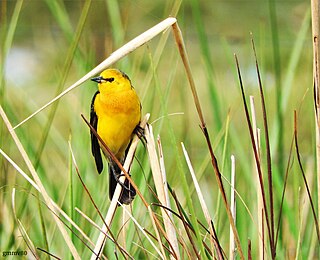
The saffron-cowled blackbird is a species of bird in the family Icteridae. It is the only species placed in the genus Xanthopsar. It has bright yellow underparts and black or dark brown upperparts. It is found in Argentina, Brazil, Paraguay, and in Uruguay at the Quebrada de los Cuervos. Its natural habitats are subtropical or tropical dry lowland grassland, subtropical or tropical seasonally wet or flooded lowland grassland, and pastureland. It is threatened by habitat loss.

The Laysan honeycreeper, also known as the Laysan ʻapapane or Laysan honeyeater, is an extinct species of finch that was endemic to the island of Laysan in the Northwestern Hawaiian Islands. The bird was first noticed in 1828, and received its scientific name by Walter Rothschild in 1892, and was placed in the genus Himatione along with the ʻapapane. The specific name, fraithii, refers to George D. Freeth, but was misspelled, and Rothschild attempted to emend it to H. freethi in a later publication. This was accepted by most subsequent authors throughout the 20th century, and it was also considered a subspecies of the ʻapapane for most of this time, H. sanguinea freethii. By the 21st century, after further research, the original name was reinstated and it was considered a full species again. As a Hawaiian honeycreeper, a grouping within Carduelinae, its ancestors are thought to have come from Asia.
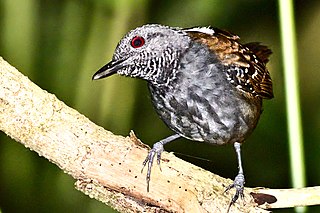
The Magdalena antbird is a species of bird in the family Thamnophilidae. It is found in Colombia and Venezuela. Its natural habitats are subtropical or tropical moist lowland forests and subtropical or tropical moist montane forests.
Current Island is an island in the Bahamas, located in the district of North Eleuthera. The island had a population of 38 at the 2010 census. The island is separated from the island of North Eleuthera by a channel known as the Current Cut, which is a site used for diving.






















